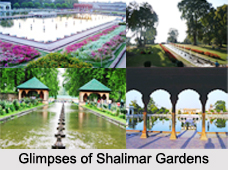 History of Shalimar Gardens or Shalimar Bagh is counted from the early era of 75 AD. While the recent history and development of the Mughal types of gardens is credited to Emperor Jahangir, the ancient history of the garden can be traced to the 2nd century when it was built during the reign of Pravarsena II.
History of Shalimar Gardens or Shalimar Bagh is counted from the early era of 75 AD. While the recent history and development of the Mughal types of gardens is credited to Emperor Jahangir, the ancient history of the garden can be traced to the 2nd century when it was built during the reign of Pravarsena II.
Naming of Shalimar
The word "Shalimar" in Sanskrit means abode of love. The king, on his visits to a local saint by the name Sukarma Swami at Harwan, used to stop at this cottage. Over the years, the cottage fell into ruins and later could not be located. However, the name of the village remained as Shalimar.
Early History of Shalimar Gardens
Praversena II founded the city of Srinagar and ruled in Kashmir from 79 AD to 139 AD. He had built a cottage for his stay at the north-eastern corner of the Dal Lake and had named it Shalimar.
Medieval History of Shalimar Gardens
It is here that Emperor Jahangir built his celebrated Shalimar Bagh, his dream project to please his queen. He enlarged the ancient garden in 1619 into a royal garden and called it `Farah Baksh`. He built it for his wife Nur Jahan. In 1630, under Emperor Shah Jahan"s orders, Zafar Khan the governor of Kashmir extended it. He named it "Faiz Baksh". It then became a pleasure place for the Pathan and Sikh governors who followed Zafar Khan. During the Mughal period in particular, Emperor Jahangir and his wife Nur Jahan were so enamoured of Kashmir that during summer they moved to Srinagar with their full court entourage from Delhi at least 13 times. Shalimar Bagh was their imperial summer residence and the Royal Court. They crossed the arduous snowy passes of the Pir Panjal Mountain range on elephants to reach Srinagar, now in Srinagar District of Jammu and Kashmir. During the rule of Maharaja Ranjit Singh the marble pavilion was the guest house for European visitors, mostly the British East Indian Company traders and French East India Company Traders.
Modern History of Shalimar Gardens
The electrification of the premises of Shalimar Gardens was done during Maharaja Hari Singh"s rule, who was the last Emperor of Jammu and Kashmir, before the Independence of India in 1947. Thus, over the years, Shalimar Gardens was extended and improved by many rulers and called by different names, but the most popular name "Shalimar Bagh" continues to this day. It is now the paradise for the tourists, who are visiting Jammu and Kashmir.
Related Articles
Medieval History of India
Islamic Architecture
Mughal Architecture
Gardens in Mughal Architecture
Shalimar Garden
Jammu and Kashmir
Tourism In Jammu And Kashmir



















